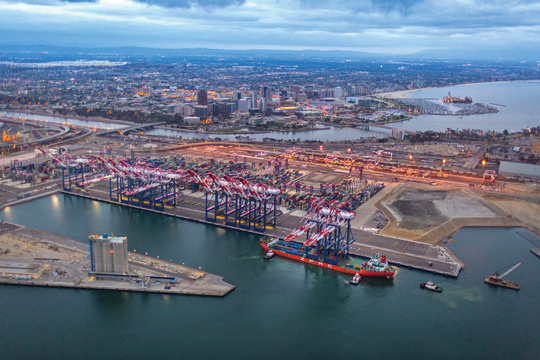Australian investment firm Macquarie Group Ltd. took a major stake last week in one of the West Coast’s largest and most technologically advanced seaport operations at the Port of Long Beach, buying out Hong Kong-based shipping company Orient Overseas International Ltd.
And, while it may not appear that Macquarie’s expertise is hauling and handling container cargo, it’s not the first financial firm to bet big on infrastructure assets at Southern California’s ports.
Analysts said the long-term nature of port operating agreements and the consistent flow of global trade translate into steady returns, which has made the San Pedro port complex — and many other top trade hubs around the world — targets for private equity groups, infrastructure funds, alternative asset managers and others.
“Infrastructure, particularly in premier locations, offers low volatility and somewhat of a protected downside and most importantly, in the example of container terminals, a really strong cash yield,” said Patrick Bird, managing director and head of global advisory at New York-based Seabury Capital. “There is clearly interest across the space.”
Macquarie is leading a consortium that plans to pay OOIL $1.78 billion for rights to run the Long Beach Container Terminal, OOIL said April 30. The container-handling terminal is known as one of the most advanced in California, with fully automated equipment capable of moving the equivalent of 40% of the entire port’s 2018 volume.
“It’s an eye-popping number,” Bird said. “The asset itself is clearly world class. All things considered, it is a fair price.”
If the deal is approved by the port and U.S. officials, Macquarie will control the operating company that holds a lease with the Port of Long Beach extending through 2051. OOIL will continue providing stevedoring and terminal services at LBCT for 20 years as part of the deal.
Moody’s Corp. analyst Moses Kopmar said the structure of the deal is typical for North American terminals, which are often run by an operating company, partnered with a shipping line and a financial backer. That’s the case for nearly all of the dozen terminals on San Pedro Bay.
“The capital to fund investment in terminals wasn’t always available to shipping companies,” Kopmar said. “It can be tough for a terminal on its own to finance a $500 million or $300 million project.”
Port authorities that lease terminals can be wary of financial entities trying to flip terminals for short-term financial gains, so they often impose a series of contract provisions that ensure minimum volumes, investments and other protections.
Most U.S. ports have leverage to do so because they have the final stamp of approval on these deals as the property owners.
Strategic investment
Infrastructure and private equity funds have increasingly taken interests in port terminals, taking the reins from family-held businesses and global shipping enterprises in recent years. Analysts say part of the draw for investors is the size and stability of the terminal operations.
California Public Employees Retirement System, the nation’s largest public pension fund, holds several port assets among its investments, according to its 2017-18 annual investment report. Blackstone Group, a multinational investment firm, said in March that its infrastructure fund was investing in Carrix Inc., among the largest U.S. seaport operator with 16 container terminals in the Americas, including one in Long Beach. Terms of the investment weren’t disclosed.
Brookfield Asset Management Inc. holds a 49% stake in International Transportation Inc., a holding company that owns TraPac Inc., which operates the San Pedro Bay’s other automated terminal at the Port of Los Angeles.
Industry analysts trace the shift in port operations ownership back more than a decade to when financial firms began creating large infrastructure funds attractive to institutional investors and pension funds looking for stable investments.
One of the earliest sales came 12 years ago when Dubai’s port operator DP World sold several container ports to a subsidiary of insurer American International Group Inc. AIG renamed the terminal assets Ports America Inc., and they were later spun off and acquired in 2014 by downtown-based Oaktree Capital.
Ports America is now one of the largest independent marine terminal operators in the United States and is in more than 42 ports, including those on San Pedro Bay.
“This is indicative of the valuable assets investors are finding in port authorities, in port operations,” Port of Long Beach Executive Director Mario Cordero said. “Investing in capital improvement projects is not only good for the ports, but it’s good for investors.”
Automating to move cargo
The Long Beach port authority has sunk $1.5 billion into the Long Beach Container Terminal, known as Middle Harbor. When complete, the terminal will be able to handle an annual capacity of 3.3 million 20-foot equivalent units, a standard measure for container cargo.
“The automation makes this a preferred terminal because they can operate at a lower cost than any terminal in the gateway,” said Jeffrey Holt, managing director of power, utilities and infrastructure at the Bank of Montreal.
Holt said a terminal in the Southern California gateway — the nation’s top hub for trade with Asia — would likely have a targeted 13% to 15% return. “That’s the beauty of this, and that’s why they paid so much.”

